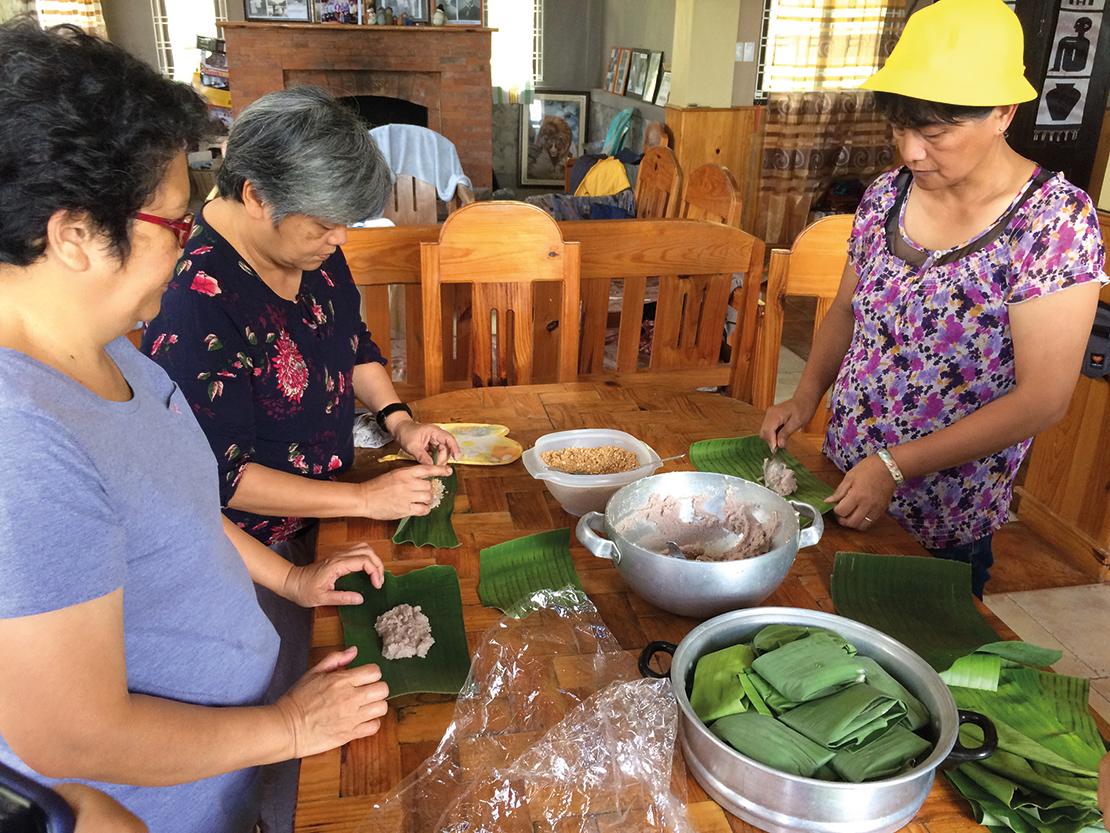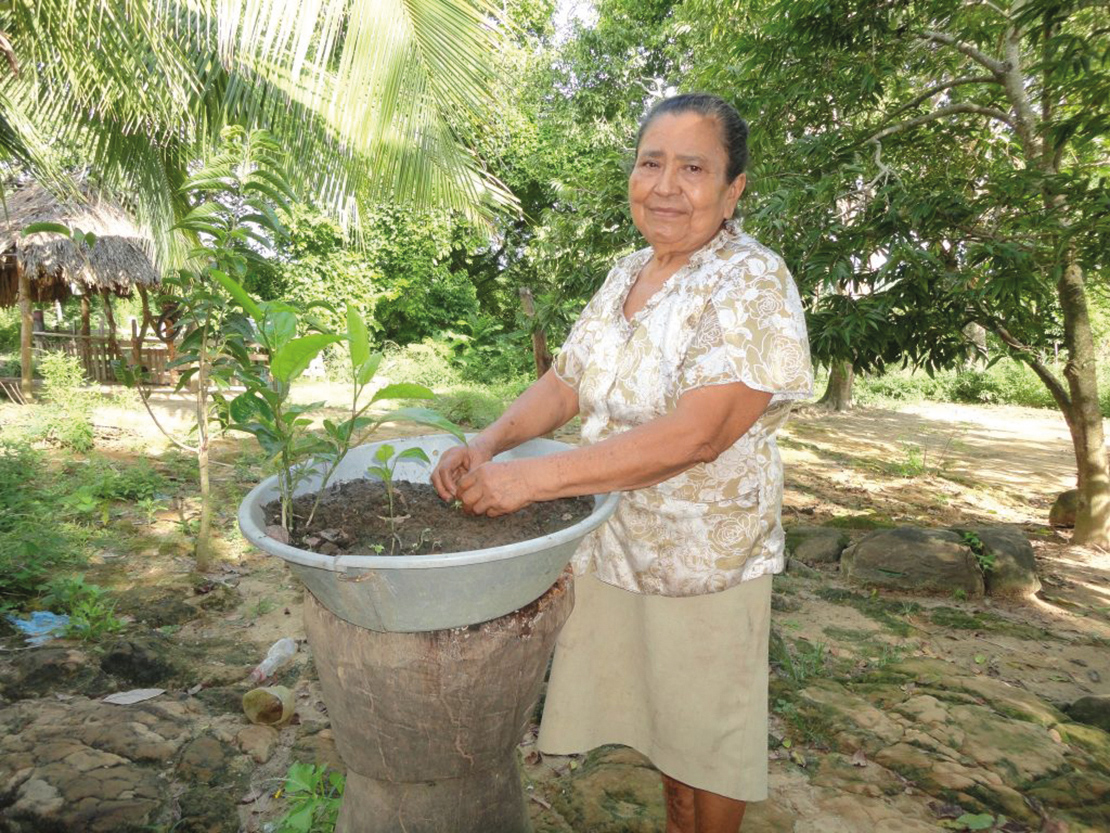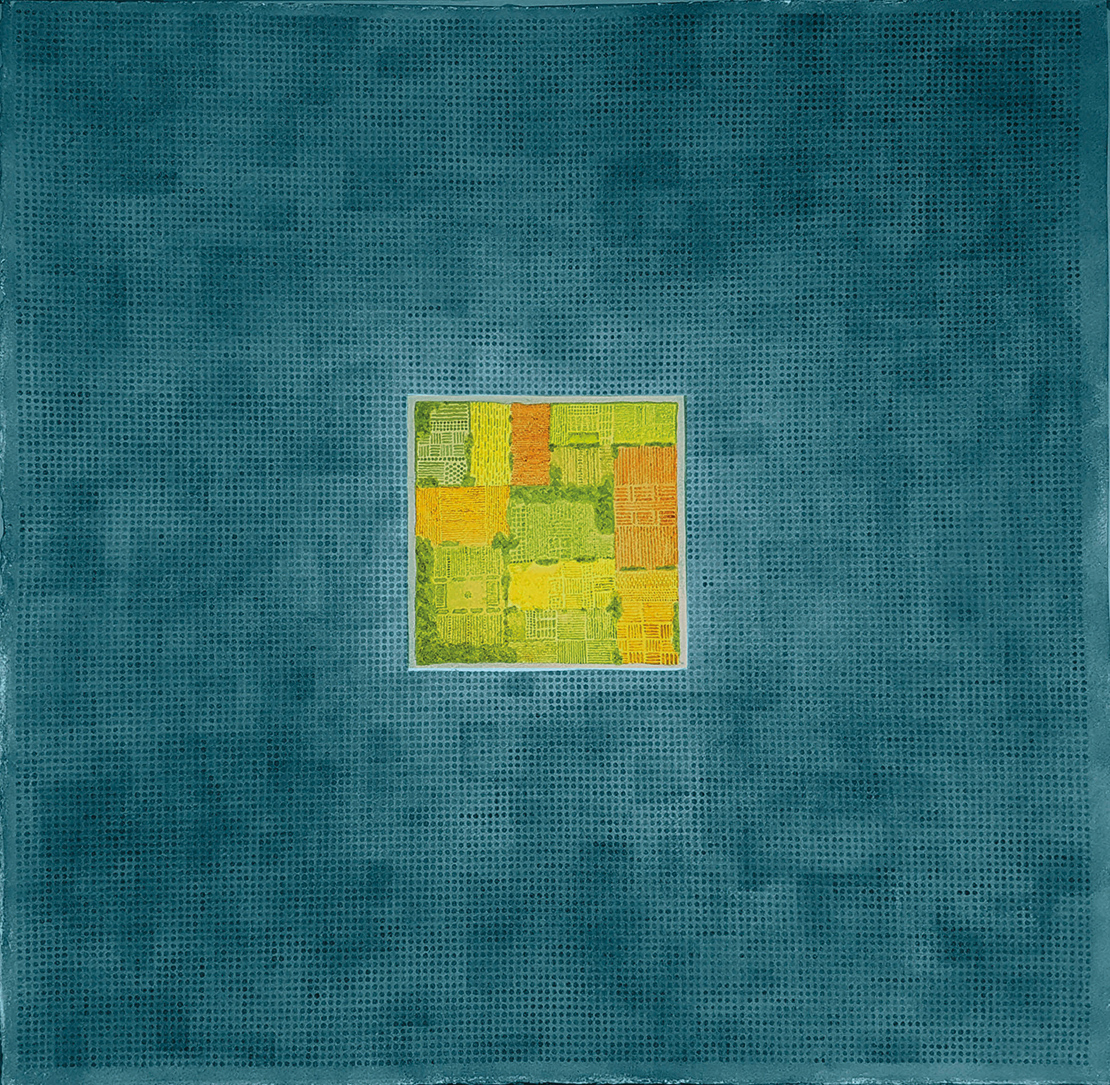
Target 13: Safeguarding genetic diversity
By 2020, the genetic diversity of cultivated plants and farmed and domesticated animals and of wild relatives, including other socio-economically as well as culturally valuable species, is maintained, and strategies have been developed and implemented for minimizing genetic erosion and safeguarding their genetic diversity.
Key messages
- For millennia, through their customary sustainable use practices and traditional knowledge, IPLCs have created, maintained and nurtured biological and genetic diversity in agriculture for the purposes of food, medicines and cultural values.
- Globalised agro-industrial food systems, which are linked to land dispossession and land-use conversions, continue to displace and transform local food-production systems; in many cases, they are undermining local food security, and human health and wellbeing, and are eroding genetic diversity.
- IPLCs are acting to renew and revitalise indigenous and local food systems as part of broader social movements for food sovereignty and agroecology; safeguarding genetic diversity; and contributing to local livelihoods, improved health and nutrition, and self-determined development.
The elders still order us
The elders still tell us,
Order us to conserve the taro seeds
Tell us to preserve the yam seeds
To save at least 30 kinds of seeds
Even in a famine, we will not die.
— Hta (poem) of the Karen people, Thailand
Significance of Target 13 for IPLCs
Diverse local economies underpinned by subsistence values have prevailed over much of human history, much longer than more recent industrialised food regimes. IPLCs have evolved dynamic relationships with the lands and waters with which they have lived, using traditional knowledge and customary sustainable use practices for food production and community livelihoods.1 Indigenous food systems embodying cultural values and governed by customary institutions have promoted community wellbeing and solidarity; collective action and ritual celebrations; and spiritual values of care and reciprocal relations with the natural world.

Women work in rice terraces that climb the hills of Luzon Island. Credit: National Geographic Image Collection / Alamy Stock Photo.
Contributions and experiences of IPLCs towards Target 13
Livelihood diversity
The Kyrgyz nomad diet is described as based on livestock activities, simple in preparation and cooking, rich in protein and calcium, good for transportation and storage, and meals are usually taken together with the family.2 African pastoralism relies heavily on livestock as a source of economic and social wellbeing, comprising at least 50 per cent of the average pastoralist household’s production (both subsistence and marketed). Pastoralists are the custodians of key natural resources found in arid and semi-arid areas covering 40 per cent of Africa’s land mass; they move strategically to access water, pastures and other grazing resources. Pastoralist culture is part of the cultural heritage of Africa. Animals and plants in pastoral areas are among the most important genetic resources on the continent.3
Indigenous food systems rooted in traditional small-scale agriculture are well established agricultural systems that generate great diversity of domesticated crop and animal species; this diversity is maintained through customary resource management and sustainable use practices, and sustained by indigenous institutions and knowledge systems. Localised food systems have provided the foundations of people’s nutrition, incomes and economies in culturally specific ways and in highly diverse contexts around the world.
Seed and crop diversity
Seed maintenance and local seed exchanges have been important for plant domestication, exchanges of improved crops, and maintenance of crop biodiversity. Seed flows (through the market or through other forms of seed exchange) are networks through which planting material flows and genetic diversity is disseminated and conserved. Today, many IPLCs continue to maintain home gardens with high landrace4 diversity and species diversity, contributing to conservation in situ.
Box 30: Partners for Indigenous Knowledge Philippines
Making imbuleh, an indigenous dish from the Cordillera. Credit: PIKP.

Case study: Heirloom recipes of the Cordillera, Philippines
Extract from a recipe book of indigenous peoples in the Cordillera region of the Philippines.5
— Read the full case study
Culinary uses often drive women to maintain a variety of landraces in their home gardens. For example, women in West Asia maintain a high number of cereal, legume and fruit tree landraces, which are seen as better suited for traditional meals, jams, and syrups than their commercial counterparts.6 When it comes to the wild relatives of cultivated species, women again play a key role in their conservation. For example, in Armenia’s Erebuni State Reserve, rich in biodiversity, it is mainly women who pass down their knowledge of crop wild relatives through the generations.7
Box 31: Astrid Álvarez
Carmen Tirado tending to seedlings in the community of Flores de Mochá. Credit: CEPALC.

Case study: Engendering biodiversity, Zenu Women, San Andrés De Sotavento, Colombia8
The Zenú women of Colombia use their critical knowledge of natural resources and cultural practices in the meaningful space of the front yard, or patio, which survives despite the fragmentation of their ancestral territories over the past three centuries. The Zenú de San Andrés de Sotavento reserve is located in the Caribbean region of Colombia, and although the Zenú people possessed a land title for 83,000 hectares of land dating from the colonial era, their territory underwent a series of fragmentations, first at the hands of the Spanish State and later by the newly established and strengthened Colombian State in the republican era.
— Read the full case study
On a global scale, a study by ETC Group9, highlights the contributions of peasants to global genetic diversity: “Peasants have bred and donated (to national and international gene banks) 2.1 million varieties of 7,000 domesticated plant species. 80-90% of peasants’ seeds are saved, shared or locally traded […] Importantly for adapting to climate change, peasants protect and sometimes interbreed 50,000–60,000 wild relatives of cultivated species at no cost, with a potential economic value of $196 billion. While many of these species are minor crops, they may be important to countries or ecosystems as essential ‘famine foods’.”
Hundreds of millions of rural people regularly turn to local food systems in times of scarcity. Ironically, many of the world’s farmers and small-scale food producers are also among the world’s poorest in terms of cash incomes and adequate food.
Threats to agricultural biodiversity
Rapid transitions from subsistence economies to market-oriented production systems are changing local livelihoods, food systems, traditional diets and nutrition, and the health and wellbeing of IPLCs; they are also disrupting women’s customary productive roles, and management and control in local food systems. Land-use changes associated with large-scale mono-crop production of agricultural commodities are displacing multi-mosaic landscapes rich in genetic diversity.
Today, indigenous food systems persist, but they are threatened and marginalised by a global food regime shaped by the neoliberal tenets of deregulation, international trade liberalisation, reduction of public expenditure, and privatisation. The 2019 IPBES Global Assessment on Biodiversity and Ecosystem Services found that: “Globally, local varieties and breeds of domesticated plants and animals are disappearing. This loss of diversity, including genetic diversity, poses a serious risk to global food security by undermining the resilience of many agricultural systems to threats such as pests, pathogens and climate change. Fewer and fewer varieties and breeds of plants and animals are being cultivated, raised, traded and maintained around the world, despite many local efforts, which include those by indigenous peoples and local communities”.10
Enabling conditions
Strategies to maintain genetic diversity need to be seen through the lens of the power dynamics governing the current food regime. Multi-level economic, social, cultural and political governance systems decide on the policies and strategies affecting genetic diversity and associated diversity in food systems and ecosystems at local, national, regional and global scales. The interactions between local food initiatives and the dominant regime on food and agriculture will shape the future of genetic diversity, including the struggle for control of seed between the corporate seed companies and smallholder farmers, and the effects of genetic engineering and terminator technologies11 on seed diversity and seed sovereignty.12
Safeguarding genetic diversity requires amplifying IPLCs historic and ongoing dynamic management of genetic resources, which optimise the diversity and complementarity of species; increase synergies between crops, livestock and trees; maximise resource efficiency and productivity; and enhance ecosystem functions and resilience.13
Supporting IPLC customary resource management and sustainable use practices will guarantee the recovery and reproduction of biological resources and increase the availability of diverse, nutritious, sustainably produced and culturally appropriate food for healthy diets.
Renewal and revitalisation of indigenous and local food systems, as part of a broad social movement for food sovereignty and agroecological transitions, would safeguard existing in-situ pools of genetic diversity and contribute to local livelihoods, improved health and nutrition, food sovereignty and self-determined development.14

Foods and seeds from the Krayan Highlands. Credit: Ellias Yesaya.

Plantations and deforestation have a grave impact on the ways of life of nearby communities, who, despite these encroachments, often play a vital role in preserving biodiversity. This illustration depicts subsistence agriculture surrounded by plantations. Credit: Agnès Stienne, Dépaysages de palmiers à huile, Visionscarto.net.
Opportunities and recommended actions
- IPLCs should redouble their efforts to revitalise indigenous food systems, including: strengthening community-based institutions; values and knowledge transmission; technological innovations; and livelihoods.
- Governments should adopt comprehensive policies to empower customary sustainable use and management of lands, waters, territories and resources—including security of customary land tenure and protection from harmful agro-industrial interventions and technologies—while upholding the free, prior and informed consent of women, men, elders and youth.
- All actors must take ‘whole system’ approaches to safeguarding genes, species and ecosystems by establishing inclusive multi-level partnerships, platforms and networks on sustainable food systems, biodiversity, nutrition and ecosystem restoration, while ensuring full and effective participation of IPLCs.
- All actors should uphold farmers’ rights and empower farmers to maintain, develop and manage crop genetic resources, including through seed fairs and community seed banks, and rewarding them for their indispensable contributions to the global pool of genetic resources.
- All actors should enhance knowledge and information on the state of genetic diversity, including through community participatory research and by documenting tangible and intangible cultural heritage across the landscape, including transboundary exchanges.
Key resources
- Food and Agriculture Organization of the United Nations (2018) ‘High-level expert seminar on indigenous food systems: Building on traditional knowledge to achieve Zero Hunger’. 7-9 November 2018. Rome: FAO. Available at: http://www.fao.org/fileadmin/user_upload/partnerships/docs/LAST_FINAL_REPORT_HLESIFS_2018_01.pdf
- International Panel of Experts on Sustainable Food Systems (2016) ‘From uniformity to diversity: a paradigm shift from industrial agriculture to diversified agroecological systems’. Bonn: International Panel of Experts on Sustainable Food Systems. Available at: http://www.ipes-food.org/_img/upload/files/UniformityToDiversity_FULL.pdf
- ETC Group (2017), Who will feed us? The Peasant Food Web vs The Industrial Food Chain, 3rd ETC Group. Available at: https://www.etcgroup.org/whowillfeedus
- FAO and IFAD (2019) United Nations Decade of Family Farming 2019-2028: Global Action Plan. Rome: FAO. Licence: CC BY-NC-SA 3.0 IGO. Available at: http://www.fao.org/family-farming/detail/en/c/1195619/
- General Assembly resolution 73/165, United Nations Declaration on the Rights of Peasants and Other People Working in Rural Areas, A/HRC/RES/39/12 (2018).
- International Treaty on Plant Genetic Resources for Food and Agriculture. Available at: http://www.fao.org/plant-treaty/en/
References
- Food and Agriculture Organization of the United Nations (2018) High-Level Expert Seminar on Indigenous Food Systems: Building on traditional knowledge to achieve Zero Hunger. 7-9 November 2018, Rome. Available at: http://www.fao.org/fileadmin/user_upload/partnerships/docs/LAST_FINAL_REPORT_HLESIFS_2018_01.pdf
- Sabyr, G. (2018) ‘Agro-Biodiverse cropping and pastoralism system of the Kyrgyz People in mild altitude mountains’. Presentation at the High-Level Expert Seminar on Indigenous Food Systems, 9 November 2018. Rome.
- IUCN Pastoralist Portal. Available at: https://www.iucn.org/theme/ecosystem-management/our-work/global-drylands-initiative/iucns-work-drylands/world-initiative-sustainable-pastoralism-wisp/pastoralist-portal
- A local cultivar or animal breed that has been improved by traditional agricultural methods.
- Cariño, J. (2019) (ed.) Heirloom Recipes of the Cordillera. Baguio: Task Force for Indigenous Peoples Rights and Partners for Indigenous Knowledge Philippines.
- Abdelali-Martini, M., Amria, A., Ajlouni, M., Assi, R., Sbieh, Y., and Khnifes, A. (2008) ‘Gender dimension in the conservation and sustainable use of agro-biodiversity in West Asia’, The Journal of Socio-Economics 37, pp. 365–83.
- Hunter, D. and Heywood, V. (2010) Crop Wild Relatives: A Manual of in situ Conservation. London and Washington D.C.: Earthscan.
- Alvarez, A (2005). ‘Mujeres Zenu: manejo, uso y conocimiento de la biodiversidad: un aporte a la soberanía alimentaria, la medicina y la cultura material’, in Escobar, E.M., Escobar, P., Pazmiño, A. and Ulloa, A. (eds.) Mujeres indígenas en los escenarios de la biodiversidad. UICN, Oficina Regional para América del Sur, Fundación Natura de Colombia and Colombia, Instituto Colombiano de Antropología e Historia.
- ETC Group (2017) Who will feed us? The Industrial Food Chain vs. The Peasant Food Web, 3rd Edition. ETC Group. Available at: http://www.etcgroup.org/sites/www.etcgroup.org/files/files/etc-whowillfeedus-english-webshare.pdf
- IPBES (2019) Summary for policymakers of the global assessment on biodiversity and ecosystem services of the Intergovernmental Science-Policy Platform on Biodiversity and Ecosystem Services. S. Díaz, J. Settele, E. S. Brondízio E.S., H. T. Ngo, M. Guèze, J. Agard, A. Arneth, P. Balvanera, K. A. Brauman, S. H. M. Butchart, K. M. A. Chan, L. A. Garibaldi, K. Ichii, J. Liu, S. M. Subramanian, G. F. Midgley, P. Miloslavich, Z. Molnár, D. Obura, A. Pfaff, S. Polasky, A. Purvis, J. Razzaque, B. Reyers, R. Roy Chowdhury, Y. J. Shin, I. J. Visseren-Hamakers, K. J. Willis, and C. N. Zayas (eds.). Bonn, Germany: IPBES. Available at: https://doi.org/10.5281/zenodo.3553579
- Terminator Technology genetically engineers plants to produce sterile seeds at harvest.
- Harris, J., Anderson, M., Clément, C. and Nisbett, N. (2019) ‘The political economy of food’, IDS Bulletin 50(2). Brighton: Institute of Development Studies. Available at: https://bulletin.ids.ac.uk/index.php/idsbo/article/view/3031
- FAO and IFAD (2019) United Nations Decade of Family Farming 2019-2028. Global Action Plan. Rome: FAO and IFAD. Available at: http://www.fao.org/3/ca4672en/ca4672en.pdf
—
The International Treaty on Plant Genetic Resources for Food and Agriculture (n.d.) The International Treaty on Plant Genetic Resources for Food and Agriculture. Rome; The International Treaty on Plant Genetic Resources for Food and Agriculture. Available at: http://www.fao.org/plant-treaty/en/ - International Panel of Experts on Sustainable Food Systems (2016) From uniformity to diversity: A paradigm shift from industrial agriculture to diversified agroecological systems. Bonn: International Panel of Experts on Sustainable Food Systems. Available at: http://www.ipes-food.org/_img/upload/files/UniformityToDiversity_FULL.pdf
—
General Assembly resolution 73/165, United Nations Declaration on the Rights of Peasants and Other People Working in Rural Areas, A/HRC/RES/39/12 (2018).


